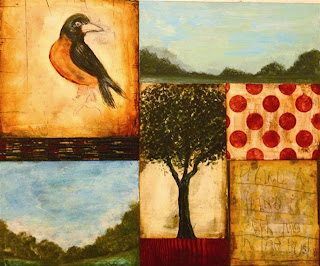 Seattle artist Craig Kosak says this about his work in the show:
Seattle artist Craig Kosak says this about his work in the show:My current work is inspired by encounters during a tour of national parks in the summer of 2005. The goal of the trip was to gather subject matter for a series of landscape paintings and I spent weeks hiking in the wilderness of Yellowstone, Glacier, and the Grand Tetons.
The trip, as it turned out, became something of a vision quest – where I would indeed find inspiration for a new body of work, though it was not the inspiration I sought. Lovely as the landscapes were, what stuck with me were repeated encounters with wildlife – especially ravens and buffalo. Over and over again, and quite by surprise, I found myself in their company as if they had a message for me. My work is an exercise in understanding that message, of seeing the world, and the human condition through new eyes.
Hints of mythology and an altered view of time are starting to appear in the work, presenting themselves for further study and exploration. Each painting explores the way these beings see the world and wonders how their perspective might improve our lives.

.jpg)
.JPG)
